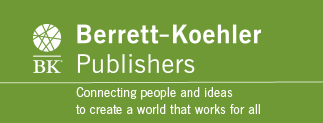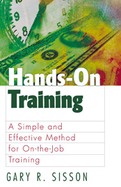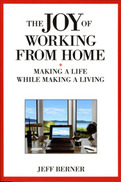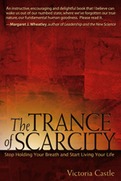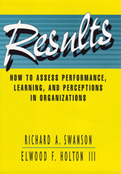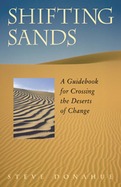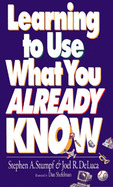2001
- The first book to detail a systematic, practical, and easily applicable approach to On-the-Job Training (OJT)
- Outlines a simple 6-step process that those performing OJT can easily follow to train workers to do their jobs
- Presents a proven approach to training workers on job skills that is truly low cost and high return-and does not require extensive documentation or long development times
BOTH PRAGMATIC AND INSPIRING, The Joy of Working from Home shows the current or prospective home-office worker how to set up an efficient home office and provides the support for making what for many will be a major life change. Combining detailed, useful information with encouraging advice and anecdotes, the book gives numerous positive examples of individuals who have successfully made the transition. The author-himself a home-worker for many years-provides realistic methods for striking a healthy balance between business and personal life.
Addressing the vital questions of lifestyle, and the difficult trade-offs between work and personal priorities, The Joy of Working from Home offers guidelines for wisely allocating every home worker's most valuable resource: time. It shows:
o how to organize both work and workspace efficiently;
o the inherent advantages of using a home-based office to achieve practical and personal rewards;
o techniques for avoiding the stress and distress of letting the demands of work and family intermingle.
Drawing on the experiences of many home-based workers, this book helps solve the problems of self-discipline, financial insecurity, isolation, and interruptions. It also offers valuable advice on dealing with the vulnerabilities that inevitably come with self-employment-creating a professional image, maintaining a positive attitude, nurturing the capacity to persist against obstacles, and developing the flexibility to deal with a variety of clients or customers.
The practical aspects of running a business out of a home office are also addressed. The Joy of Working from Home provides useful strategies for creating a business plan, low-cost marketing techniques, tips for networking in the community, and ways to keep expenses down. There is down-to-earth advice for avoiding the pitfalls of zoning and tax requirements, information on purchasing office equipment and supplies, and guidelines for contracting outside services. A resource section creates access to important publications, home-based business associations, government agencies, and database information for effective business and professional marketing.
This book will appeal to a broad spectrum of current and prospective home office candidates, including the newly self-employed professional, the budding entrepreneur, those weary of the corporate work environment or long commutes, and those determined to restore the balance between their personal and professional lives.
- Written for the 30 million people currently working from home, and the millions more-predicted to embrace one-third of the work force-who will take advantage of this alternative in the next few years
- A complete guide for meeting the practical and personal challenges of successfully working from home on either a part-time or full-time basis
• Describes how we trap ourselves into believing we're never good enough and never have enough
• Offers simple but powerful practices for breaking out of this scarcity mentality and living a life of abundance
• Weaves humorous personal stories throughout the book
In her own life and through her work with others, Victoria Castle has repeatedly encountered the tragic theme of "not-enough-ness"--both the "I am not enough" and "There is not enough" varieties--and witnessed how it cripples even the most buoyant and passionate people among us. Castle calls this blight the Trance of Scarcity. It shows up in a hundred personalized versions, but the results are always the same. Instead of expressing our brilliance and creativity, we show the world only the by-products of oppression, isolation, exclusion, and defeat. We spend our time lamenting the way things are, justifying all the reasons they can't be different.
In this inspiring and very personal book, Castle shows that there is life on the other side of the Trance -- a life characterized by vitality, fulfillment, and efficacy. She shares specific practices you can use to change your story--to identify and interrupt negative, constraining patterns and replace them with more positive and liberating ones to achieve greater freedom, fulfillment, and satisfaction.
With compassion and surprising humor, The Trance of Scarcity will help you embody abundance as your way of being. Once you do, you'll be more inspired and more inspiring, you'll build bridges to replace dead ends, and you'll easily arrive at solutions to issues that once overwhelmed you. Having broken free from the Trance of Scarcity, you'll be able to live a life where ease and plenty emanate from you as naturally as your breath.
1999
This book presents a practical guide to building a successful, competitive, and cost-effective HRD practice that meets customers' needs. Results teaches readers a highly effective, easy-to-learn, field tested system for assessing organizational results within three domains: performance (system and financial), learning (knowledge and expertise), and perceptions (participant and stakeholder).
Why measure results in HRD? Because the "corporate school" and "human relations" models of HRD practice, whereby development occurs simply because it is good for employees, no longer works. If HRD is to be a core organizational process, it must act like one and hold itself accountable. Measuring results, particularly bottom-line performance results, is key to gaining support from top management. And those who measure results ultimately find it a source of program improvement and innovation as well as pride and satisfaction.
While Results is theoretically sound, it is firmly rooted in practice, offering a core five-step assessment process that gives readers a simple and direct journey from analysis inputs to decision outputs. Whether they have assessment tools but no theory, theory but no tools, or no tools and no theory, this book will equip them to quickly and effectively assess their results.
- Shows human resource development (HRD) professionals how to measure organizational results within the domains of performance, learning, and perceptions using the effective and efficient Results Assessment System
- This widely praised system simplifies the complex issues of assessment, enabling HRD professionals to clearly demonstrate their results
- Real-life examples illustrate how the principles work
- From the author of Analysis for Improving Performance , winner of the 1995 Outstanding Instructional Communication Award from the International Society for Performance Improvement and the 1995 Society for Human Resource Management Book Award
2004
• Uses the gripping real-life story of the author's journey across the Sahara as a compelling metaphor for understanding difficult and uncertain times
• Offers six rules of desert travel to help readers gracefully cross their own personal deserts
They clarify previously confusing thoughts, simplify complex situations, and point the way to new and better ways of doing things.
Is there a way to encourage the kind of "aha!" perceptions that leave us feeling enlightened and empowered? Are there methods for facilitating the flashes of understanding that make us holler "eureka!" or smile with quiet contentment? Though insights may feel like they come out of the blue, Stumpf and DeLuca make us aware of the process behind the flash so that we can stimulate our capacity for learning and growth.
Beginning with the premise that each of us knows more than we think we do, Stumpf and DeLuca provide a reflective process that integrates all of our conscious and unconscious resources. They share their insights, grounded in common daily work-life situations, to prompt readers' own perceptions into everything from getting along with coworkers to being a visionary leader, understanding the meaning of service in a job, coping with technological change, and remaining competitive in the global economy.
Organized to mirror the insight-to-learning process, each chapter of Learning to Use What You Already Know starts with an insight, provides an example for reflection, summarizes the context with a lesson statement, and concludes with questions to stimulate the readers' thoughts. Examples and anecdotes from the authors' lives show how they arrived at an insight and, since new concepts do not always emerge in words, key ideas are whimsically illustrated.
With humor, and, well, insight, Stumpf and DeLuca show readers how to become their own source of lifelong learning. The tools in Learning to Use What You Already Know help readers turn what they've learned in order to survive into the creative understanding that will help them thrive personally and professionally.
- How to turn the knowledge, experience, and skills we take for granted into meaningful insights
- A practical and fun-to-use guide to increasing personal and interpersonal effectiveness at work
- Ways to cultivate insights-about problems, people, and situations-that bring enjoyment and build the mind's capacity to interact with people and ideas
